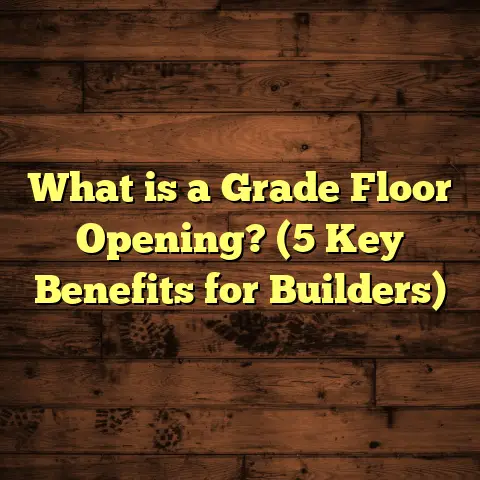What is a Floor Support Beam Called? (5 Key Types Explained)
I still remember the first time I encountered hemlock timber on a job. It wasn’t just any wood—it was light, almost creamy in color, with a grain that felt both strong and flexible under my hands. This was no ordinary material; it was part of the hidden framework holding up the floor I was standing on. That moment made me realize how critical floor support beams are—they’re the silent heroes beneath every step we take in a home or building. Most people don’t think twice about these beams until something goes wrong. But having worked in this field for over a decade, I’ve learned that understanding these beams makes all the difference when it comes to safety, design, and cost.
What Is a Floor Support Beam?
When I say “floor support beam,” what am I really talking about? At its core, a floor support beam is any structural member designed to carry and distribute loads from the floor system down to the foundation or other load-bearing elements. It’s often made from wood, steel, or engineered materials and runs horizontally beneath the floor surface.
These beams act like the skeleton of the floor system—without them, your floor would be unstable, uneven, or worse, dangerous. The loads they carry include:
- The weight of the floor itself (dead load)
- Furniture, appliances, and people (live load)
- Environmental factors like snow, if outdoors (additional live load)
How Do Floor Support Beams Work?
Structurally speaking, beams resist bending forces (called bending moments). When you stand on a floor, your weight pushes down. The beam bends slightly but must be strong enough to hold your weight without excessive deflection or failure.
The beam transfers this load to columns, foundation walls, or other vertical supports. The design challenge is sizing and spacing these beams so they can carry expected loads safely without being overly expensive or bulky.
For example, I once inspected a home where the floors sagged noticeably over a 12-foot span. The culprit? Undersized joists acting as beams. Replacing those with properly sized laminated veneer lumber (LVL) beams solved the problem quickly.
Why Floor Support Beams Matter More Than You Think
Have you ever walked into an older house and noticed a slight dip or bounce in part of the floor? Or heard a creaking noise when someone walks across? These are classic signs that support beams—or their connections—may be compromised.
I can’t count how many times clients have called me worried about what they assumed was a minor squeak turning out to be a serious structural problem. One homeowner found their floor joists had rotted near the rim joist because of trapped moisture. Fixing that meant replacing entire sections of beams and reinforcing others.
Here’s some data from studies by the National Association of Home Builders:
- Over 20% of homes older than 50 years have some form of floor beam deterioration.
- Floor deflection beyond 1/360th of the span length is generally considered noticeable and unacceptable.
- Properly sized beams can reduce floor bounce by up to 40%, improving comfort and perceived quality.
This is why understanding different types of floor support beams is essential, especially if you’re considering renovations or repairs.
1. Joists: The Everyday Workhorses
Joists are the most common type of floor support beam you’ll encounter. They’re smaller than main beams but numerous, spaced closely to support the subflooring directly.
What Makes Joists Special?
Joists run parallel across the room, typically spaced 16” or 24” on center. Their size varies depending on span length and load—common sizes are 2×8, 2×10, or 2×12 lumber.
I recall working on a Victorian-era home where original joists were made from dense old-growth pine. They were spaced 20” apart instead of modern 16”. The owners wanted to add a heavy fireplace insert upstairs. We had to sister new joists alongside the old ones to strengthen the floor—adding load capacity without removing existing joists.
Types of Joists
- Solid Wood Joists: Traditional dimensional lumber.
- Engineered Joists: Such as I-joists made from laminated veneer lumber (LVL) flanges with OSB webs.
Engineered joists are increasingly popular because they’re lighter, stronger per inch, and less prone to twisting or shrinking.
Joist Span Table Example
| Joist Size | Species | Max Span (ft) at 40 psf live load |
|---|---|---|
| 2×8 | Southern Pine | ~11-13 |
| 2×10 | Douglas Fir | ~15-17 |
| LVL 1.75in x 11.875in | Engineered LVL | ~20-22 |
These spans vary based on species, grade, and spacing but give you an idea of how far joists can stretch before needing additional support.
2. Rim Joists: The Hidden Boundary
Rim joists might not get much attention because they’re hidden along walls but they’re crucial for maintaining joist alignment and transferring lateral loads.
Why Rim Joists Matter
They act as a border frame connecting all ends of joists while tying the floor system into the foundation or walls.
In one renovation project with an exposed basement wall, we found extensive water damage had rotted out rim joists. Because rim joists carry some vertical and lateral load, replacing them was necessary before installing new flooring above.
Installation Tips
- Use pressure-treated lumber in moisture-prone areas.
- Secure with structural screws or bolts rather than nails for better hold.
- Apply sealants to prevent moisture intrusion.
3. Headers: Bridging Open Spaces
Headers are specialized beams installed perpendicular to joists where there are openings like stairwells, chimneys, or large ductwork chases.
What Do Headers Do?
When you cut out joists to create an opening, headers take over their load-carrying responsibility by spanning across those openings.
I remember working on a two-story home addition where we needed to create a large stairwell opening. Choosing the right size header beam was key—it had to carry not just floor loads but also wall loads above. We used doubled LVL headers bolted together for strength.
Material Considerations
Headers are often double or triple laminated beams made from:
- Dimensional lumber doubled up
- Laminated veneer lumber (LVL)
- Steel beams for larger spans
Using engineered materials reduces beam size while providing greater strength.
4. Ledger Boards: The Wall Anchors
Ledger boards are horizontal members fastened to walls that support one end of floor joists—often seen in deck construction but also inside buildings.
Their Role in Load Transfer
Ledger boards transfer loads from joists back into the wall framing or foundation.
In several deck projects I’ve done, improper ledger attachment has led to catastrophic failures—decks collapsing because ledger boards were attached only with nails instead of lag bolts or through-bolts.
Best Practices for Ledger Boards
- Use pressure-treated lumber outdoors.
- Fasten with lag screws or bolts spaced according to local codes.
- Flash ledger boards properly to prevent water damage.
5. Main Beams (Girder Beams): The Heavy Lifters
Main beams carry concentrated loads from joists across long spans to columns or foundation walls.
Why Main Beams Are Essential
In basements or large open spaces without many walls, main beams bear most of the floor weight above.
On one commercial project with wide open office floors, steel I-beams were indispensable for supporting long spans without column clutter.
Common Main Beam Materials
- Solid sawn lumber (glulam beams)
- Laminated veneer lumber (LVL)
- Steel I-beams or wide flange beams
Sizing Main Beams
Main beams are sized based on:
- Span length
- Load intensity
- Structural material properties
For example, an LVL main beam spanning 30 feet can carry approximately double the load of a similarly sized solid wood beam.
How Beam Materials Compare: Wood vs Steel vs Engineered Wood
Choosing material affects strength, cost, installation complexity, and longevity.
| Material | Pros | Cons |
|---|---|---|
| Solid Wood | Widely available, aesthetic appeal | Prone to warping & rot |
| Engineered Wood | Stronger per inch, less shrinkage | Higher upfront cost |
| Steel | Very strong & durable | Expensive & requires special tools |
When working on a historic home recently, we opted for LVL beams over steel because installation was easier and LVL matched wood framing better aesthetically.
Dealing With Old and Damaged Beams: Lessons From My Fieldwork
I’ve come across many homes with compromised beams due to rot, insect damage, or poor original construction. Here’s what I’ve learned:
- Always inspect for moisture damage—wood rot often starts unnoticed.
- Sistering (adding new joists alongside old) can restore strength if original beams aren’t too far gone.
- Reinforcing with steel plates or flitch plates (steel sandwiched between wood) can extend life.
- Replace rim joists promptly if damaged; they keep the entire floor system aligned.
One memorable case involved replacing a rotten main beam under a porch where dry rot had eaten through half its thickness. We installed a steel flitch beam that provided more than double original strength without raising the porch floor level appreciably.
Real-Life Case Study: Reinforcing Floor Support Beams in a Century-Old Home
A client’s house was built in 1903 with original pine joists spanning nearly 18 feet—longer than recommended for their size. They wanted to add a heavy wood-burning stove upstairs but feared floor instability.
After thorough inspection using moisture meters and load calculations based on current building codes (IBC), we decided on sistering joists with LVL members and adding two steel girders beneath main spans.
Results:
- Floor deflection reduced from approx 3/4 inch over 18 feet to less than 1/8 inch.
- Noise from creaks eliminated.
- Stove safely installed with proper load-bearing support.
This job took careful planning but saved the historic character while upgrading structural integrity.
How to Measure and Calculate Beam Requirements Yourself
If you’re curious about how professionals size beams:
- Determine Span Length: Measure distance between supports.
- Calculate Loads: Estimate dead loads (floor materials) plus live loads (people/furniture).
- Consult Span Tables: Use span tables from building codes or manufacturers.
- Consider Beam Deflection Limits: Usually L/360 for floors (meaning deflection must not exceed span length divided by 360).
- Choose Material Type: Wood species or engineered products have published strengths.
- Factor in Safety Margins: Typically around 10–20% extra capacity added.
There are handy online tools too—like FloorTally—that help calculate costs based on your inputs and local rates.
Common Questions About Floor Support Beams
Q: Can I replace wood beams with steel?
A: Yes! Steel offers high strength and smaller beam sizes but requires welding or bolting expertise and sometimes fire protection coatings indoors.
Q: What causes floor beam failure?
A: Moisture intrusion causing rot is most common; poor design or undersizing; insect damage; physical impact; improper fasteners can also weaken beams over time.
Q: How often should beams be inspected?
A: Every few years in older homes; after floods or leaks; before major renovations.
Final Thoughts from My Decade Working With Floor Support Beams
I’ve learned that while floor support beams might not be glamorous or visible parts of your home, they’re absolutely essential for safety and comfort. Knowing about different types—from joists to main girders—and their roles gives you power when planning renovations or troubleshooting issues.
If your floors feel soft or noisy—or if you’re planning to add heavy furniture—consider checking those hidden beams! Sometimes simple sistering or adding engineered beams can save you thousands in repairs later on.
Remember: strong floors start with solid support beneath your feet!





